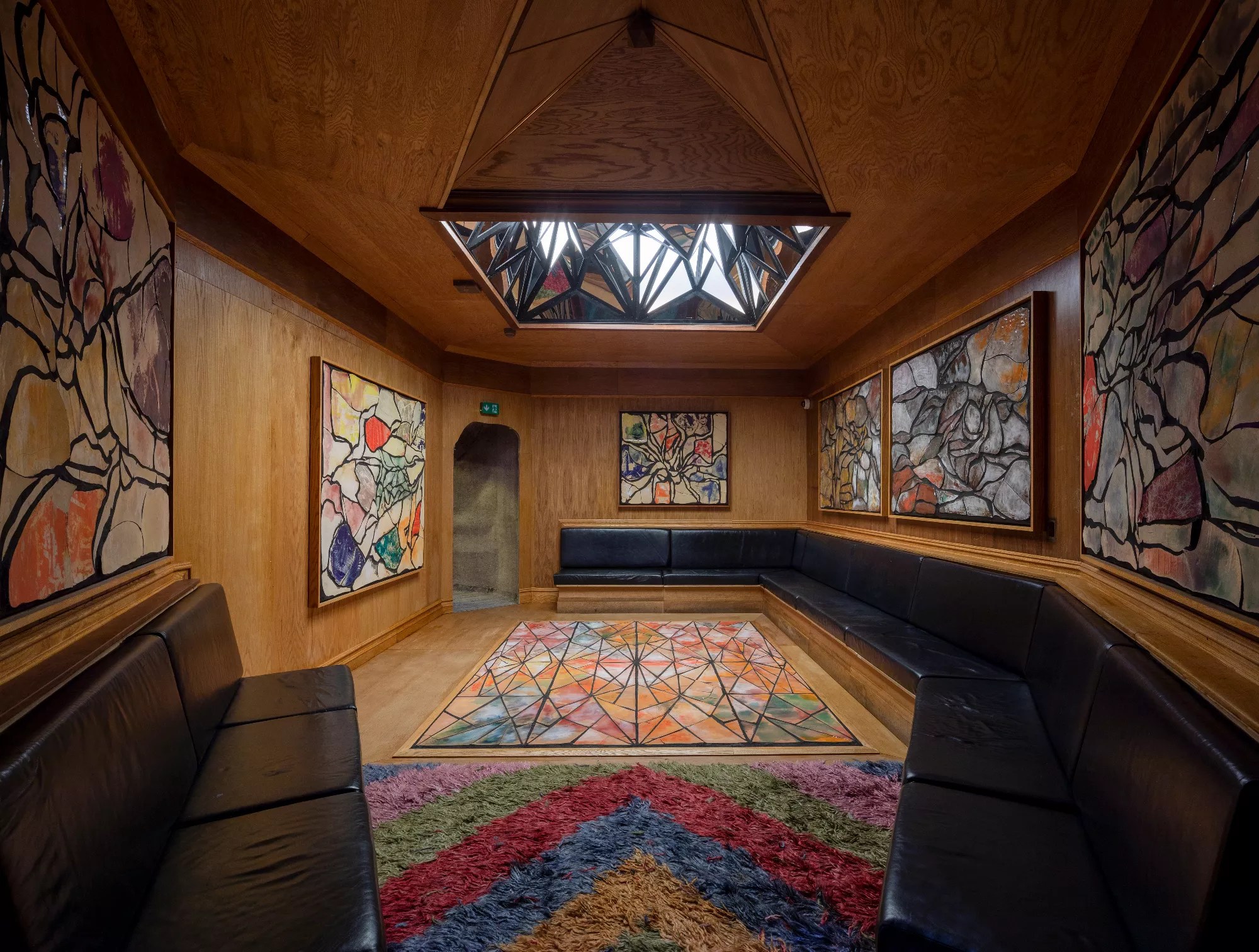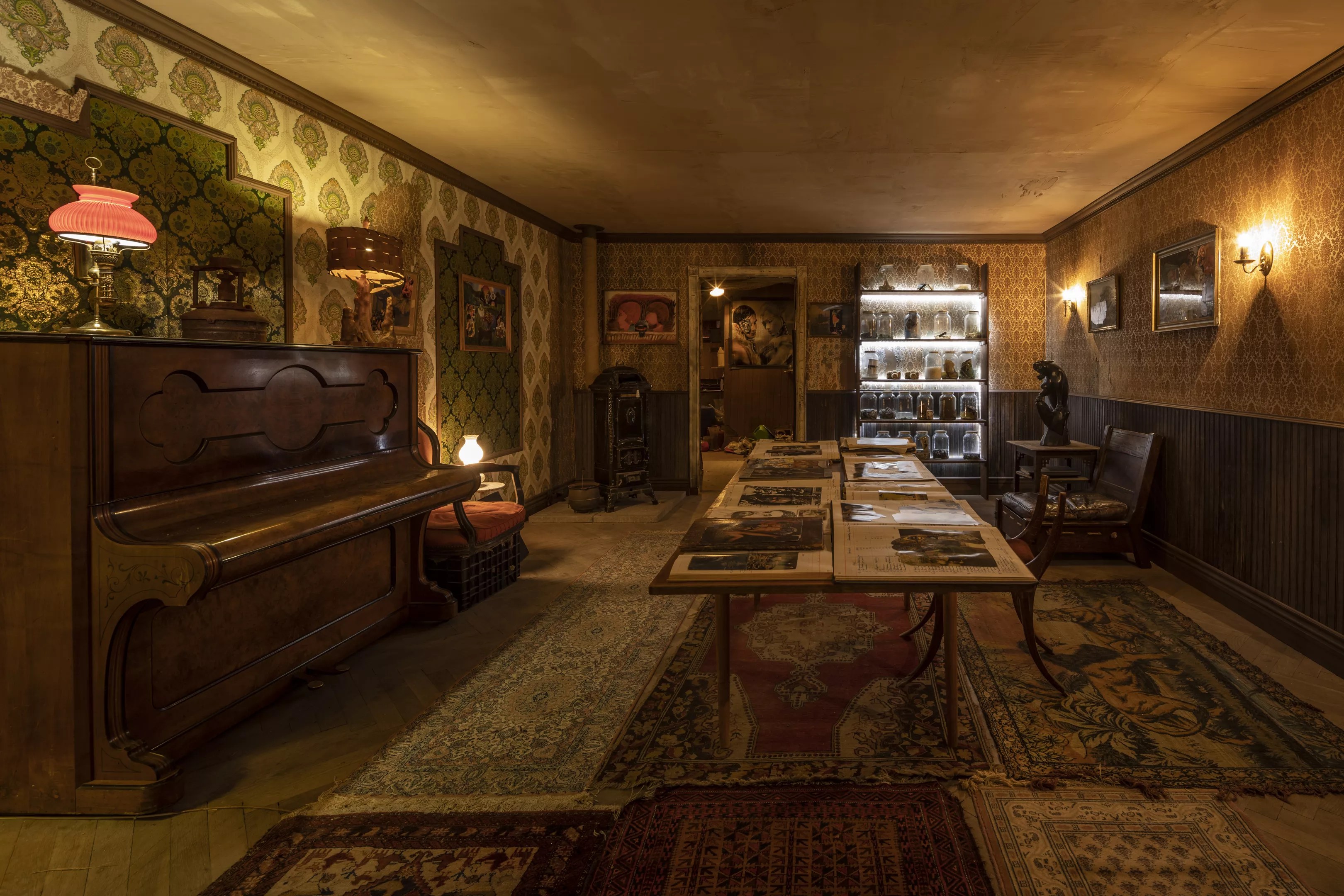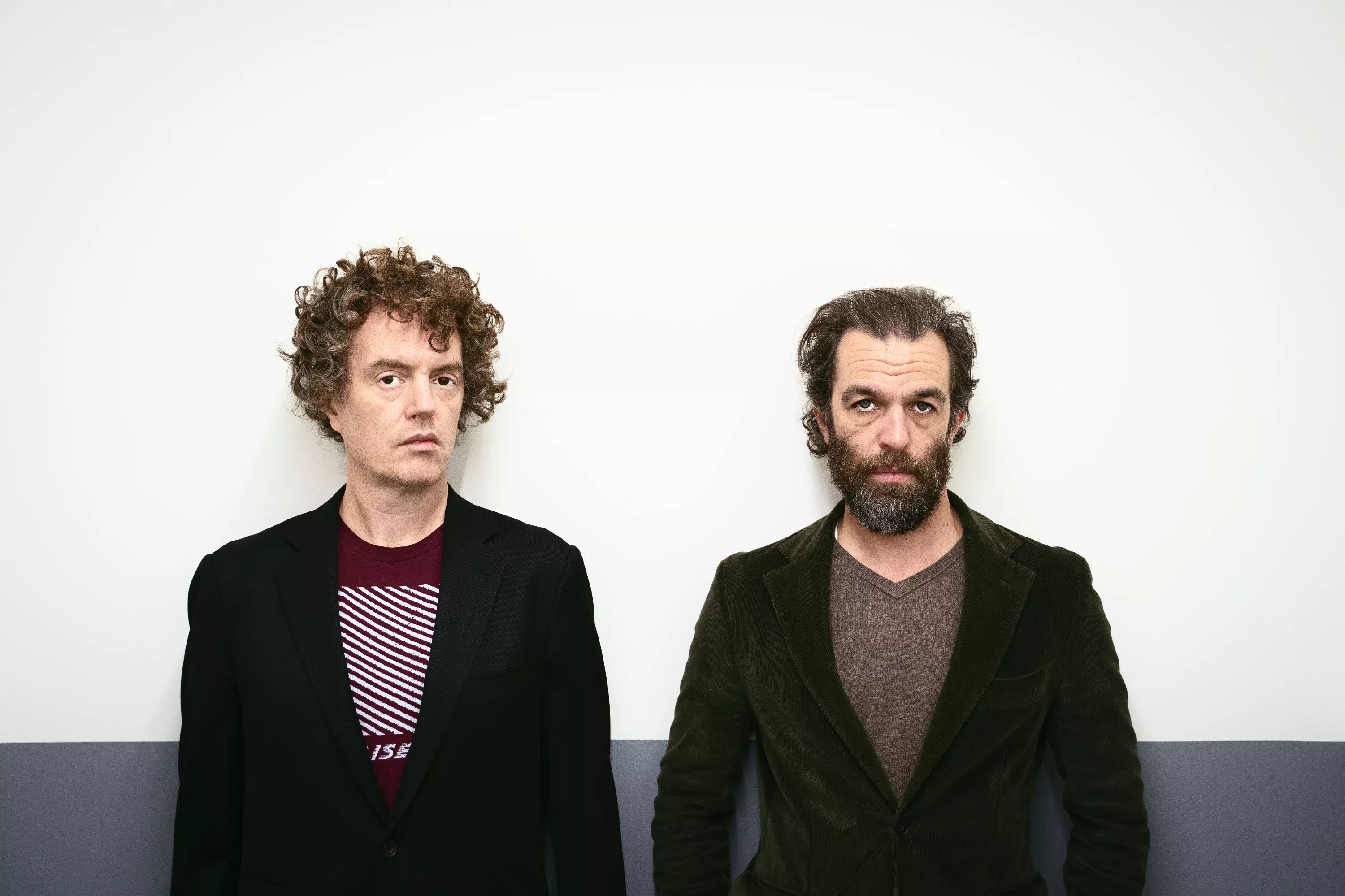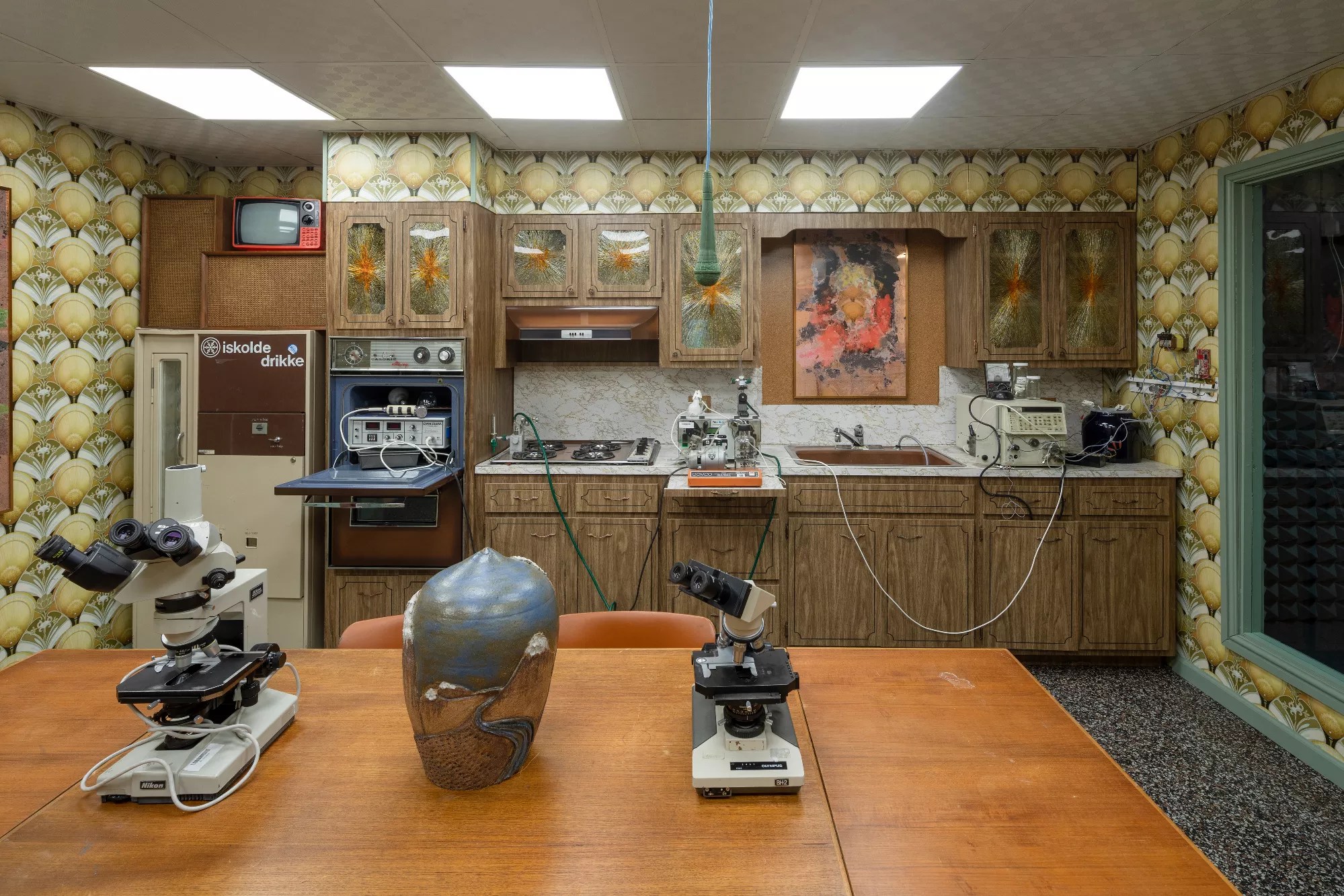
Jens Henrik Daugaard/courtesy of San San International©

Audio By Carbonatix
One of North Texas’ most ambitious exhibitions of 2024 is a sprawling metanarrative equally obsessed with California counterculture and the dawn of technological innovation in Silicon Valley.
But as the viewer enters the drywall entrance into six architectural zones (plus a cinema!) that take over a chunk of the Modern Art Museum of Fort Worth‘s second floor, the unfolding narratives feel less like a straightforward story and more like a strange visit to a sci-fi movie set, one in which the actors just wandered off to craft services.
On view through Jan. 5, Sunset Corridor is in fact the 14th (and latest) chapter of what artists Jonah Freeman and Justin Lowe call the “San San Universe.” Originally posited by Herman Kahn and Anthony Weiner in the 1967 book The Year 2000, this futurist theory speculated that San Diego and San Francisco would eventually merge by the turn of the 21st century.
Obviously, this didn’t come to pass, but if it had, we’d no doubt have a similar pastiche of biotech science and hippie vibes. In the Corridor, specimen jars litter dusty shelves, a tangle of power cords connects outmoded electronics and copiers are crafted of (no doubt macrobiotic) black rice. As you move through the spaces created by New York artists Jonah Freeman + Justin Lowe, you can come to your own conclusions about what these visual collages mean.
This year, make your gift count –
Invest in local news that matters.
Our work is funded by readers like you who make voluntary gifts because they value our work and want to see it continue. Make a contribution today to help us reach our $30,000 goal!
Working together since 2007, Freeman and Lowe have complementary backgrounds that have helped inform each of their out-of-this-world exhibitions. Obsessed with the idea of hybrids, the two approach a concept within their own unique practices to bring it to life.
“Jonah went to film school, so he had a lot of knowledge of how commercial photography can take over a space and build an image that way, and I had a background in sculpture,” Lowe says. “He was dealing with a lot of light and space, while I was dealing with more volume and simulations and simulacra – like I’m going to take the front of the gallery and turn it into a replica of a bodega, or I’m going to use a revolving door that will take you into the back of an ice cream truck.
“When we moved out of working with paper collage and started thinking about the world as collage, he took video cameras and would cruise through the neighborhoods in Brooklyn and look at the window displays for source material.”
The pair first gained attention for their 2008 project in Marfa, titled “Hello Meth Lab in the Sun,” which looked at the production of crystal methamphetamine as an analogy for anatomy. Also employing a warren of rooms that transitioned from scene to scene like a cinematic cut, that installation trafficked in the same mind-blowing immersive strategy Meow Wolf would employ eight years later with its first permanent space in Santa Fe, New Mexico.
But Freeman + Lowe always approach things from an intellectual, sequential standpoint.
Whereas early spaces in Corridor are dense and cluttered, they eventually open up to a more soothing environment, a form of “spatial collage” the creative partners have perfected in their years working together.

Jonah Freeman + Justin Lowe, “VAPOR(SHADE)”
Jens Henrik Daugaard/courtesy of San San International©
“When we’re trying to create the different sequences and genres of rooms, you’re saying this is going to be a 1970s kitchen, or this is going to be a hippie commune, or this is going to be an abandoned office,” says Freeman. “You’re working through color, texture, furniture and props, deciding what you’re going to find and what you’re going to make. There’s a lot of evolution and a lot of discussion going into it.”
Adds Lowe, “It’s also very dependent on the site where the installations will take place. You want to slowly create a moment of, ‘Oh wait, things are getting different now.'”
Corridor, which has been in development since 2021, builds on an exhibition the duo initially undertook the following year at the ARoS Arhaus Kuntsmusem in Denmark. Given the expense of creating unique environments, carrying over elements both thematic and constructional made sense for the artists, who like to really dig into a theme from every angle.
In fact, the concept of Corridor has “been present in our work from the beginning,” says Freeman. “It’s this notion of how the counterculture and mainstream culture intersected in an antagonistic way. There’s also the symbiotic relationship that was the premise for ‘Meth Lab,’ which began our career and has been there all the way. It’s based on this fictional notion of a neo-biological information network that humans are using for analog transmissions. This was developed by IBM during the Cold War as an experimental technique.
“They tried it out, and it didn’t work. It was left dormant and then found by a counterculture, an underground music world that uses technology like a Discord channel. In this sense, what we’re seeing at the Modern are these various rooms that have mainstream industrial functions that are taken over and remixed.”

Artist duo Jonah Freeman + Justin Lowe (right) have collaborated since 2007.
Jens Henrik Daugaard
Gathering ephemera that ranges from bad thrift shop paintings to VHS tapes and old electronics, the artists were influenced by the surroundings they used to build their constructions – in this case, a former IBM office in Kingston, New York. The resulting “parallel world” of spy music and drug culture, New Age religions and CIA ideology twists the “tune in, turn out, drop out” ethos into an unreal land that makes perfect sense in a time when billionaires are just dying for humans to merge with AI.
Freeman + Lowe’s version of the future may be no less absurd and unreal than our current reality, but its take on the speculative fiction of Philip K. Dick and Thomas Pynchon is, at least, a little bit more fun. Instead of the “Dark Enlightenment” beloved by Theil and Musk, you’ve got Natural History Museum-style dioramas and a soundtrack by Sun Ra, Gang Gang Dance’s Brian DeGraw and Jennifer Herrema of Royal Trux, all of whom contributed music to the installation’s ending film.
As both the real and imagined Freeman + Lowe counterculture revolves around music, it makes sense that the artists consider this a crucial element in their efforts to push against the mainstream world. And it’s just another entry point that establishes Sunset Corridor as the type of show you can experience at your own time, on your own level of pop culture.
As deep and multi-layered as the work is, the artists themselves say there’s no real right or wrong way to explore Corridor. Bur Lowe recommends viewers “stick around for the whole duration of the film [that ends the exhibition], then walk back through it again.
“It’s about spending time – there’s nowhere to go,” he adds. “Don’t twist your perspective on all the objects you’re seeing; it’s a generative thing, and it’s designed to get you thinking, which is really the point.”
Sunset Corridor runs through Jan. 5, at the Modern Art Museum of Fort Worth, 3200 Darnell St.

Jonah Freeman + Justin Lowe, “RANDOM FOREST (THE WHISPER IN THE KITCHEN),” on display at the Modern Art Museum of Fort Worth.
Jens Henrik Daugaard/courtesy of San San International©